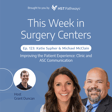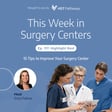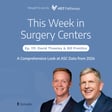Introduction to 'This Week in Surgery Centers'
00:00:01
Speaker
Welcome to This Week in Surgery Centers. If you're in the ASC industry, then you're in the right place. Every week, we'll start the episode off by sharing an interesting conversation we had with our featured guest, and then we'll close the episode by recapping the latest news impacting surgery centers. We're excited to share with you what we have, so let's get started and see what the industry's been up to.
Key Benchmarks from HST Industry Report
00:00:27
Speaker
Hi, everyone. Here's what you can expect on today's episode. Last week, we held a live online event with Will Evans. Will is the Senior Director of Data Science and Insights here at HST Pathways, and we spent an hour reviewing 10 of the most compelling clinical and financial industry benchmarks from HST's latest State of the Industry report.
The Role of Data-Driven Operations in ASCs
00:00:50
Speaker
So if you haven't seen it, we've released a state of the industry report in late September and it includes best practices, key process steps, over 125 KPI ideas and benchmarking data for every step of the patient journey and for nearly every recurring administrative duty as well.
00:01:09
Speaker
We are in an era where data-driven operations are really the only option and using data to inform your work and being surgically precise in how you operate is critical to thrive. And surgery centers that embrace this shift will be the ones who remain on top. So that is really why we wanted to take the time to not only create the report, but also dissect the top 10 key metrics that came out of the report and help you embrace this mindset and get started.
00:01:38
Speaker
So, if you have ever wondered what other surgery centers are experiencing for average block time utilization, case cancellation rates, patient deposit collection rates, average net revenue per case, now is your opportunity to get a window into how you're tracking and performing. Hope everyone enjoys the episode and here's what's going on this week in Surgery Centers.
Interactive Webinar with Erica Palmer
00:02:06
Speaker
Hi, everybody. Thanks so much for joining us this afternoon. I'm Erica Palmer with HSC Pathways, and I'll be moderating the webinar today.
00:02:15
Speaker
If you've been to any of our webinars before, you know my usual spiel, but this webinar is truly for you. So we do want it to be as interactive as possible. So please use the Q&A box at any time. If anything comes up and I'll make sure that either Will or I can address the question that you have. Don't be shy. We want to get all of your questions.
00:02:37
Speaker
especially with the data that we're showing, it is unique to HSC and we want it to be a discussion, you know, if you're seeing different metrics at your surgery center, let's talk about it.
00:02:49
Speaker
All right, so what are we going to do today? We are in the middle of our welcome and housekeeping items right now.
Best Practices for Optimizing ASC Operations
00:02:56
Speaker
I wanna take a moment to introduce the report to you as well. Obviously today we're focusing on 10 industry benchmarks, but those benchmarks did come from a report that we published last month and then talk a little bit about why this stuff matters. And then I promise we will spend the bulk 90% of this hour talking about those 10 key metrics.
00:03:20
Speaker
So I've already introduced myself. I'm on the marketing side at HSC, and then I'm super excited to have Will Evans with us today. He is our senior director of data science and insights, and we would not have been able to produce a report like this or get into kind of the nitty gritty of some of these data points without Will's guidance. So really excited to have him with us today.
00:03:49
Speaker
Okay, so if you're not familiar with the report, I'm gonna put it in the chat whenever I have a second, and then it'll be in next week's email. You'll be redirected to the report when this webinar ends. So I'll make sure that you have access to the report itself.
Challenges and Solutions in ASCs
00:04:05
Speaker
But what we decided to do was publish a report focusing on best practices and proven data for optimizing ASC operations. So it's a pretty extensive report,
00:04:18
Speaker
There's over 45 chapters with a ton of different data points and most importantly, a lot of KPIs. So we're always, you know, encouraging surgery centers and clients to focus on data. And with doing this report, we're trying to give you some examples of how to get started.
00:04:35
Speaker
Or if you've already been doing it for years and data is a core piece of what you're doing. I would love your thoughts on the KPIs that we shared. If you think we missed any or you know just general feedback of really trying to get everybody started on the kind of the data front here.
00:04:52
Speaker
And the report itself has six key chapters. We really try to look at the entire patient journey from the moment the doctor and the patient decide, yes, we're moving forward with surgery, you know, all the way down to the moment where they are being discharged from your facility. So we're looking at pre-day of service, day of service and post.
00:05:12
Speaker
and then we're looking at the regularly recurring operations. So what should you be doing on a daily and weekly basis?
Strategies for ASC Success
00:05:18
Speaker
What should you be doing on a monthly, quarterly basis, and then an annual basis as well? So again, I will send this report, but the 10 data pieces that we'll be looking at today all came from this report and there's even more in there. Okay. So,
00:05:38
Speaker
Why are we here? Why does this data matter? Kind of where is the surgery center going? So what we're seeing across ASCs is that the world has really changed from what it used to be. It used to be a lot easier to manage things in an ASC, but things are getting more and more challenging. Reimbursements are stagnant or even lowering. In some cases, competition is increasing across the board. More hospitals are getting involved
00:06:08
Speaker
taking interest in outpatient spaces than ever before. There's an increase in higher acuity cases. I don't need to talk to any of you about the staffing issues that are going on, but unfortunately it doesn't seem like there's any end in sight based on projected models. So, you know, staffing shortages, how are we gonna overcome that? And then of course, as I'm sure you're experiencing just like rising costs of everything across the board, especially supplies,
00:06:35
Speaker
you know, the economy is really taking a hit, especially for ASCs. So precision is really the only option here in the new game in town. So when we're talking to those who are most successful and the most profitable centers, they're really focused entirely on efficient data-driven precision operations.
00:06:59
Speaker
So just like all of you are so surgically precise in the operating room, we need to take that mindset and move it to the business side of the house and shift from imprecision to precision operations.
00:07:15
Speaker
And you know, we'd be hypocrites if we didn't approve this with data. So we're seeing that there's actually a huge difference between those that, that take this mindset and those that don't. Some are really succeeding and others are struggling to, you know, forget thrive and grow, but just stay in business. So two metrics that we're really seeing a difference here on is EBITDA. So basically like earnings or profit margins for businesses. And then of course block time utilization, which we'll spend some time on today as well.
00:07:45
Speaker
And when you really compare the average to those who are in the top quartile or top 10%, there's a huge difference. And it might only look like 10 or 20% across both of these metrics here, but that could equate to hundreds of thousands or millions of dollars of extra earnings, which of course could go towards all of the issues we've already talked about, staffing, supplies, recruitment, whatever your facility needs. And the difference can be really stark.
00:08:15
Speaker
And just a reminder, because I know moving quick, you're going to get the slides, you're going to get the recording so you can spend more time with these numbers as well. So what are top performers doing that is, performers doing that is setting them apart. There's really six primary things here. So
00:08:33
Speaker
being surgical with OR utilization and profitability, you know, looking at the numbers regularly, that other thing we were just talking about and trying to improve them, you know, doing things like physician recruitment and having physicians come inbound rather than you having to spend so much time and effort trying to recruit outside physicians. They're automating manual processes. We are trying to remove as much human intervention and manual labor and make things as simple and straightforward and automated for you.
00:09:03
Speaker
Of course, evaluating individual case profitability so that at the end of the month, there's no surprises, there's no panic about what cases you took on that ended up not being profitable. You know, at least you'll have the opportunity to say yes or no when a case comes across your desk, monitoring case mix and acuity, and then of course forecasting hiring needs and supply needs.
00:09:29
Speaker
And this kind of thinking and this strategic approach can really change everything for every stakeholder that touches your surgery center. So for your admins or the business office folks, it moves them from a good amount of reactive work or redundant low value tasks to being able to be proactive and work on higher value things.
00:09:52
Speaker
Uh, for your clinical team, it moves them away from doing clerical work and gets them back to what they love, which is working with patients and actually being able to use their degrees to their full potential and skillset.
Shift Towards Data-Driven Operations
00:10:04
Speaker
Physicians of course, you know, on the business side, they don't have to worry about all the nuances and they can instead think about their patients and the business as a whole.
00:10:14
Speaker
If you have management groups involved, you know, it helps them go from delayed insights to benchmarking across the whole portfolio and trying to identify patterns. And then of course financial outcomes always the goal.
00:10:29
Speaker
But if it was as easy as all of that, everybody would be in the top quartile. So we fully recognize that this is an extremely challenging place to get to. And if you're lacking automation, you're missing data, you're having all these staffing challenges and you have limited time, it's going to be really difficult to get to this place. So in the data that we're presenting to you today and kind of this mindset, we would love you all to shift into
00:10:57
Speaker
it can really help overcome some of these biggest hurdles. And then of course, HST was purpose built to help you do exactly that. We really do strive to make data live at the core of everything we do and help you run precision operations. And I hope that by the end of this webinar with the data we're sharing with you and the time we've put into this, that really comes across.
00:11:22
Speaker
All right, so enough of me for a second. Let's do a quick poll. First question, we're gonna do two polls today. This is our first one. What other sources do you use for industry benchmarking? I would love to know where else you're finding your data and kind of what you find most valuable. So I will give everybody about 30 seconds to complete this poll and then I will share all the results as well.
00:11:50
Speaker
And while you're filling out your answers, I did just put a link to the full report in the chat as well. Okay, so I'm ending the poll, sharing the results. Hopefully you can all see this, but ASCA, great resource. ASE Quality Collaboration is another great resource. I think it's potentially underutilized. I have a lot of great clinical metrics available. Awesome.
00:12:18
Speaker
All right. Thank you all so much for sharing. All right. So to the good stuff, first metric we'll be talking about today is average block time utilization. So well, I'm going to hand things over to you for a second. Can you help us understand how this data point was collected? Sure. So for this metric in particular, there's kind of two pieces that you need to put together to be able to calculate it.
00:12:44
Speaker
And so the way that we went about this and fully admitting that there are multiple ways that you can look at not just block time utilization, but OR utilization in general. The way that we calculated this here is that we identified scheduled blocks within HST and then we tied cases to that reserved block based on the physician or group that scheduled the case. So if a physician who is not part of, who is not the physician that reserved that block and is also not a part
00:13:13
Speaker
of the group that reserved that block. If they perform a case during that scheduled block time in that OR, we actually end up considering that non-block time. And so we didn't count that towards this metric. So this specific metric is really just calculated by dividing the time associated with performing cases by the physician or the physician group that scheduled the original OR block. And this is one I think like going forward in the future,
00:13:43
Speaker
There's multiple ways that we'll look at it because we'll look at block time and non-block time versus the scheduled block. And then we'll look at overall OR utilization as well. And really we would want to understand how do all those three kind of metrics work together to give you a holistic view of OR utilization and block time utilization.
00:14:05
Speaker
Perfect, thank you. Yeah, I think this was one metric that we've actually gotten a lot of feedback on so far just because of the way we calculated it and to your point the way others calculate it, it can make a huge difference in the number that we come to.
00:14:20
Speaker
But I'd like to think if we were all sitting in a room together, you would all be nodding along at the sentiment that, you know, a surgeon might have every Monday from nine to 12 blocked for them. And then most 42% of the time it ends up sitting under unused, which can be frustrating, but it also is just a huge missed opportunity for revenue generation.
00:14:44
Speaker
And we'll reference this metric again, when we actually get to our final metric, which would be year over year growth, but this could be a huge opportunity to generate more revenue for the organization. And, you know, some, I put some tips in here to improve it. I'm sure you all have a lot more.
Block Time Utilization: Importance and Strategies
00:15:02
Speaker
you could share but you know being able to share your OR availability online with office schedulers, setting internal goals for physicians and staff and just educating on the importance of high utilization I think could be really great ideas to get to increase this or lower the number of blocks when your OR is not being utilized and
00:15:26
Speaker
you know, it's tricky because of course it's all in the surgeon's hands, right? If this is their block time, trying to educate them and have a conversation with them as to like, you know, at what point can maybe we let it go and try to get other surgeries in there, whatever initiatives work, but improving this number is just a critical component to increasing your bottom line. Before we move on, there's two other notes I do want to call out about this one. When you
00:15:55
Speaker
start breaking this apart by specialty. You do see different variations in OR utilization by specialty. Like we have some gastro focused ORs and ASCs where you see this number really high, where they're up around 80 or 90%. There's also like pretty big dispersion amongst that same, the, the, the, the gastro groups. But if you drill in by specialty, you'll see different variations and just distributions of this metric. And then the other thing is,
00:16:24
Speaker
This one in particular is a great lever, as Erica mentioned later on, we'll talk a little bit more about it. But for identifying additional opportunities, if there's unused block time and you can publish that or you can release that to other, for other
Insurance Verification and Pre-Authorization Metrics
00:16:38
Speaker
availabilities, it just helps you understand more of your precision operations. Perfect. I do have three questions for you.
00:16:47
Speaker
So how do you, and also I should say for the sake of time, we might have to skip some questions, but we will absolutely save all of these and reply to all via email if we can't get to them live. But how do you track utilization for unassigned block times? We have an issue with that. Sometimes we have doctors that post a lot without assigned block time. We have a hard time figuring out how to capture that. Right now that ends up falling under the non block time. And so.
00:17:15
Speaker
When we do the math on this one, we basically have a flag where you can include or exclude that. And I'll be honest, I don't think we have a great way of, of doing it yet. That's, this is where we start to morph to thinking about overall or utilization, but that's definitely one that I think as we go through this again, uh, for 2024 and we start to calculate some of these metrics, that's more of kind of the fidelity that we would, we want to, uh, start to tease out. Definitely.
00:17:45
Speaker
Is block calculated by MD schedule time or actual patient in room time? So the block is scheduled by based on what the, what the doctor is scheduling for actual consumption of that time. There's a hierarchy within HST that you can go through where there's at certain facilities do it in different ways. And I think if you have each chart, you can literally get the
00:18:12
Speaker
entrance and exit times for the OR. But basically we step through a process of what's the highest level of granularity? Is it an e-chart based in and out time all the way down to what was just the schedule start and end times for that case. And we go through and we look at what gives us the best indicator and what we think is the highest fidelity data point to use. Thank you. And last question.
00:18:37
Speaker
I'm hoping you know the answer because I do not. How do you adjust for physicians that have flip rooms? I don't have a great answer for that one. Okay. Kelly, I'm saving this and we will get back to you. Okay. So let's keep it moving to metric number two. So here we're looking at insurance, pre-auth and verification rates. So Will, can you give us a little insight into this metric please?
00:19:06
Speaker
Sure. I'll start with insurance verification. That one's a pretty straightforward metric here. Within HST, we just went through and we summed up or we counted all the cases where they had the insurance verification complete. And so it's a simple just yes or no. And we divide that into the, the total count of cases that had insurance or that either data didn't have insurance verification. Insurance preauthorization, it's a basically a similar methodology, but for counting the yeses here,
00:19:37
Speaker
We include multiple statuses. There are some that don't require a preauthorization to be completed. And so we have to control for that. But the shortest way I think to describe this is where insurance preauthorization was not completed. That's anywhere where it's a no or it's a null value in the HSD system. And so it's the same methodology. You just sum up the yeses divided by the total base. Thank you. First question.
00:20:06
Speaker
How do you know which procedures do not require pre-auth?
Reducing Case Cancellation Rates
00:20:13
Speaker
I actually don't know. That's a good question. To be honest, in the HST system, the code that we use is NR, and that's where it's not required. But I would have to talk to one of our internal product experts to give you a good answer on that one.
00:20:30
Speaker
Sure. And so, Emily, we can definitely give you a little bit more insight there. Good question though. And I think, you know, with both of these metrics, it goes without saying that they directly impact your reimbursement and revenue collection and ultimately patient satisfaction, physician satisfaction. So really honing in on your processes and also trying to take out as much
00:20:54
Speaker
human component to it as well. And making sure that you have systems in place where you can continuously run insurance verification, you know, not just once, but whenever you would like to. So as soon as you receive the case, maybe the first of the month, you're running insurance verifications for all the cases in the upcoming month. And then on the morning of every day, every morning, you're running insurance verification for your procedures for that specific day. And if you don't have an automated way to do that, you're
00:21:24
Speaker
going to spend a lot of manual time doing it or miss cases where insurance has lapsed for a multitude of reasons. So, obviously, you know, trying to identify trends when you are having issues with this, you know, are there certain procedures, payers, are there time periods, you know, that you're experiencing most issues with this when deductibles reset on January 1, or whatever it might be, you know, fixing communication between the front office and the billing staff.
00:21:52
Speaker
utilizing technology, adjusting documentation practices, and ultimately training staff too. I think for me, that's just a big takeaway from all of this. If you haven't had the opportunity, whether it's during a staff meeting or whatever it might be, to really educate everybody within the, in the ASC walls as to the importance of all these metrics and why it matters. I think that's also just a key, education is just a key piece of this too.
00:22:21
Speaker
All right. Metric number three, case cancellation rate. So we talk about this all the time. We got a lot of questions about this. I actually saw a thread in Ask a Forum recently where someone else was looking to benchmark, you know, see if where they were at compared to their peers. Will, can you tell us a little bit about case cancellation rate, please? Sure. This is another one that was, it's a pretty straightforward calculation where we're just counting up the number of cases that were
00:22:50
Speaker
scheduled in Q1 and Q2 of 2023, but then we're canceled and dividing that by just the total number that we're scheduled. Let me see if there's, if we had any caveats in here. No, I think it's a pretty straightforward calculation on this one. Yeah, I agree. And I think this obviously it's an easy one for people to understand and an easy one for everyone to understand the impacts. So, you know, obviously it impacts your bottom line. It's frustrating for staff, physician, um,
00:23:19
Speaker
and staff satisfaction, but also patients, you know, unless they're the one doing the cancellation, but you know, this is another place where you can really improve your rates by identifying the trends. So is it patient related or is it an equipment issue? Is it just an unforeseen emergency? What is it? And then, you know, again, is it around the holidays? When are you experiencing your highest case cancellation rates year over year so that you can prepare for it?
00:23:47
Speaker
you know, automating patient text reminders and pre-op instructions. So you never have to cancel a case because a patient didn't know they didn't have to eat, whatever it might be, offering financial counseling. So is a patient arriving the day of and they're seeing their bill and they haven't seen it yet and they're stressed and they're deciding, you know, they're gonna walk right out or whatever it might be. Obviously, if you're having equipment issues, you can hold more frequent equipment and supplies checks. So first identify those trends and then you can really go from there.
Improving Patient Deposit Collection Rates
00:24:20
Speaker
All right, patient deposit collection rate. This is a fun one, Will. How did we get here? Sure. So this one, within HST, there's two fields that we use to calculate this. It's the expected patient deposit amount, and then there's the actual patient deposit collected. And so the math here is pretty straightforward. We're just dividing.
00:24:47
Speaker
the actual patient amount collected by the expected amount collected, which on the service is pretty easy to do for whole and aggregate. But we know that this isn't used by all centers. And so when we calculated this 53% number, we had to go through and basically scrub out some of the data that we knew wasn't accurate. And so generally speaking, how we did that was we looked for centers that just weren't populating the expected collection data.
00:25:17
Speaker
And in some cases they were only populating it maybe very sparsely. So to basically try to get to a high fidelity number, we would remove the centers that aren't using it or basically not using it reliably so that we could try to triangulate a number that we felt pretty good about.
00:25:35
Speaker
Perfect. Thank you. Yeah, I would love to hear in the Q&A box too. If you know any of your numbers off the top of your head for any of the metrics that we're sharing and you're comfortable putting them in the Q&A, I'd love to hear them because this number 53% collection rate on expected patient deposits, it just seems so low and I'm sure everybody would want it to be higher. We do have one question, Will.
00:26:00
Speaker
Are you assuming the center has the correct expected payment? This number changes when EOB arrives? Yes. Essentially what we're doing is we're trusting them to put in the correct amount fully knowing that, yeah, this isn't, it's never going to be 100%. I think objectively accurate data. And so that's why we're kind of declaring the metric. These are the, basically the parameters that we're using for it. Over time, I think this is some one that we can
00:26:31
Speaker
probably evolve and maybe change and look at it different ways, but yes. Perfect. Thank you. Yeah. And I know, you know, we talk about price transparency all the time here, but a very easy way or a very straightforward way I should say to increase this number is to send an accurate patient estimate to the patient as far in advance as possible.
00:26:56
Speaker
have it automated. Nobody on your side should be manually crunching numbers in order to tell a patient what they owe, and they certainly should not be finding out what they owe for the first time when they walk in the day of surgery. So, not only you know automate the process of generating
00:27:12
Speaker
The estimate, send it to the patient via text or email so that no one can ever say to you, I never received this. And then also offer them a way to pay online, have an immediate call to action and offer them credit card payment, online payment, whatever it might be. We actually did have someone share. So Diane shared, we use this as a quality study, which is a great idea. And we have went from 36, 46
00:27:42
Speaker
36 to 46% to sustaining in the high 90th percentile. So that's extremely impressive. If you would like to share what you did to get to that number, I'd love to hear it. I'm sure everyone else would. That's awesome, Diane. Thank you for sharing that.
00:27:58
Speaker
So, you know, a couple ideas, increased collections by automating that cost estimation process internally. And then of course just offering transparency at every level.
Operational Efficiency Metrics
00:28:08
Speaker
You know, of course you can do everything that you can. Patients are human. So there's that element to it, but by offering an easy way to pay in advance, you're just setting yourself up for success there. This is, this is another metric where when you,
00:28:25
Speaker
step into it and you look at the distribution of outcomes, you do see centers, as kind of Diane mentioned, where they're meeting 90%, like solidly into the 80s and 90%, they're collecting a really high rate on their expected deposits across millions of dollars. There's a weird outlier where the center doesn't do a high volume, but they do a great job of collecting on their deposits. There are centers that are
00:28:55
Speaker
legitimately outstanding at this. That's awesome. Something to strive for. Okay. So let's talk about average OR duration and recovery time. Will, can you share how we got to these numbers, please? I know they're small. Again, we'll send them out. Sure. So this one, the math for kind of.
00:29:19
Speaker
OR duration and recovery duration is pretty straightforward. It's really just what's the entry and exit times for the ORs or the procedure rooms, same thing for recovery rooms. And so it's really just identifying what's the best metric, what's your highest fidelity entrance and exit time, and then subtracting that and averaging it out. The other piece for these is how do we map to, how do we map the, basically all of the cases to specialties? And the methodology we chose is to
00:29:47
Speaker
basically use the primary CPT code associated with a case and basically map that to a specialty. And that requires some level of normalization within HST. Not everyone codes all their specialties the same way, or they don't use the same abbreviation. And so just, you know, when you think about it, some specialties like ENT, some of them are labeled as ENT with a three-letter abbreviation, whereas others are, they use OTO like otolaryngology. And so we had to do some cleanup and kind of
00:30:17
Speaker
coding of the data on the back end to, to map all the cases to specialties. Yeah. Will's being humble. He really took one for the team here and categorized all of our CVT so we can get to this nice clean graph here. So yeah, I think this is, it's just really interesting to see. And again, you know, within your own surgery center, kind of where you're trending our OR times and recovery times, increasing, decreasing. Why?
00:30:43
Speaker
Why is it happening? Because obviously the time you spent in the OR and the recovery area directly influences operational costs. So by kind of understanding and optimizing the time in the OR and in the recovery time, you can obviously improve your bottom line, but it also enhances the patient experience, increases satisfaction across the board.
00:31:07
Speaker
And on the recovery time side, you know, you're really showing that you're prioritizing the wellbeing of the patient, which will lead to positive clinical outcomes. And of course, patient satisfaction. All right. Days to bill by ORs. What do we have here, Will? Sure. So this one, again, there's kind of two pieces to how we calculate this metric.
00:31:36
Speaker
The first one, Days to Build, that's a pretty straightforward. It's really subtracting the date the first bill was sent from the admit date or the date of service. And then you can average that over any number of basically groupings. But the other piece is how do we identify the number of ORs for an ASC? And for that, essentially what we did was we went and we counted the number of unique OR and procedure room names by facility.
00:32:06
Speaker
And then using that, we were able to identify how many procedure and OR rooms the facility had. And we basically binned those into different groupings that you see on the bottom of the chart. Perfect. Thank you. And I know this was one we had gone back and forth on just because there's so many ways to kind of slice and dice and look at this data. But obviously number of ORs is kind of an equalizer that everybody can look at and relate to.
00:32:33
Speaker
Obviously, days to bill is just a key indicator of the efficiency of your entire revenue cycle. Timely billing contributes to timely reimbursement and it directly affects the speed at which your surgery center can receive payment. Obviously, the lower you can get your days to bill, the better. Optimize cash flow, reduce the risk of delayed payments. There's really
00:32:55
Speaker
There's really so much here and I think by kind of refining the billing process, if you're not at a place where you want to be or if you think you're, if you're falling short in comparison to your peers here, and you want to maintain a healthy financial position obviously there's a lot of things you can do to improve this but I think
00:33:11
Speaker
you know, investing, there's so many RCM companies investing in different technology solutions, training your staff, improving communication between departments.
Claims Denial Rates and Reduction Strategies
00:33:19
Speaker
There's a lot of different ways you can get this number down if it's too high and you know, it's taking too long to get the claims out the door. We don't have any questions. Let's do claims denied. What, what do you have here, Will?
00:33:39
Speaker
This one's a pretty straightforward calculation. Here we really just count up what are the number of claims that have a denial date or a denial reason and dividing that by the total number of claims that we had processed during the Q1 and Q2 of 2023. This one, this is one of my favorite kind of metrics to calculate, not
00:34:01
Speaker
just because it's specifically telling in itself, but very early on in my career at HST, this was one of the first kind of correlations we found between authorization rate and claim denial rates. And that we saw as authorization rates increased, claim denial rates tended to decrease. And it was just a, it was a cool study in, in kind of predictive analytics around understanding what are the drivers of claim denials and being able to trace that back to things that happened kind of on the front end of the revenue cycle.
00:34:32
Speaker
and understanding just the interplay between different pieces. Yeah, I think that's great. And again, if anyone has any, if you know off the top of your head, where you're at in terms of claims, claims and aisles, I'd love to see that in the Q and A just out of curiosity. But, you know, this obviously impacts the revenue cycle so much, you know, they,
00:34:55
Speaker
Acclaimed denial can easily result in delayed or lost revenue, which obviously can affect your overall financial stability. It also can really strain the relationship between your surgery center and payers. So again, if you're trying to find the root cause and it's, you know, you're seeing a trend with a certain payer, kind of building that relationship with them and asking them and, you know, having that conversation with them like, Hey, every time we submit this one claim with these same variables,
00:35:24
Speaker
we're getting denied. Like what are we doing wrong? How can we fix it? Really opening up that dialogue can help as well. And again, you know, when you do notice, if you do notice an uptick in the percent of claims denied, it's really time to initiate a deeper dive to understand that root cause. Is it a coding issue, documentation shortfall, again, a specific procedure that's continually getting flagged. And then from there you can focus on staff training.
00:35:51
Speaker
software and technology. So consider using advanced billing software that can help flag potential denial triggers before you submit the claim. So you kind of have that extra level of defense before it goes too far. And that alone can substantially reduce denial rates. Of course, regular audits and then engaging with payers would just be advice here if you do want to, if you are seeing some issues in this world.
00:36:18
Speaker
So before we finish up, I do just want to send out our second and final poll.
Challenges in Data Analysis
00:36:24
Speaker
I know we're talking a lot, so would love to get some engagement here. Here we go. I'm launching the second one here. What is the biggest challenge you're experiencing right now when it comes to analyzing data? Just give everybody a minute. And I know we have a lot of different organizations on the group or on the call. So whether you're a management group or.
00:36:47
Speaker
an independent ASC or consultant is all applies to you. All right, I'm going to end the poll and I am sharing the results now. This is always really interesting to see. So we're looking at data quality. Yeah, it's just tough, right? Whatever data goes in is the data you're going to get out. So trying to educate staff, get everybody on board. Here's the importance of why we have to input all these metrics, whatever it might be, lack of expertise.
00:37:16
Speaker
time constraints, data security, and just not sure where to begin. Yeah. I hope, you know, with the report that we did produce, if you're not sure where to begin, it can certainly look a little overwhelming just because there are so many KPIs and so many data points that are shared, but it could be helpful to at least pick one or two or three key metrics where you want to start and go for it. All right. Thanks everybody. So.
00:37:44
Speaker
Next, I've lost track. I think this is seven, seven, seven-ish, but here is average of days not worked by age of receivables. So take it away, Will. Sure. So this is another metric where there's a couple of different pieces that we needed to calculate to create it. I think the first piece to tackle is essentially figuring out the age days. And so to do that, we aggregated accounts with owed balances by their age, by the age of the receivables. So it's.
00:38:14
Speaker
essentially how old the receivables are since their data service or their admit date. And once you do that, you can average that over basically whatever groupings you want. And then to get to the last date that something was worked, what we did was we looked in the HST system and we identified the last date that a non-system generated note was put on an account. And that's not necessarily like
00:38:39
Speaker
a clinical note or something along those lines, it's when was the last date that that account or that case was being worked. And then basically once you figure out that date, you calculate the difference between today or the current date and that last note date to identify basically when was the last time that account was worked based on the age of that case. And then you essentially just average those last work dates by the age days and you've been the age days in 30 day increments.
00:39:11
Speaker
perfect. Thank you. Yeah, this is an important one. You've probably noticed as we're trending, we're getting into those recurring regular or regularly recurring operations that should be taking place on a weekly to monthly quarterly basis. And this is a huge one, because obviously the older receivable becomes the more challenging it can be to collect. And
00:39:34
Speaker
You know, you can really use this data to kind of prioritize follow-up on older receivables and kind of implement a systematic follow-up procedure that can hopefully reduce the number of days that a receivable becomes unworked.
Benchmarking Data Sources
00:39:49
Speaker
And analyzing specific age buckets and breaking down, like we have here, the days not worked into specific timeframes can help pinpoint where the most significant challenges lie. And again, customize strategies for each bucket.
00:40:04
Speaker
And, you know, kind of goes back to that patient deposit collection rate as well. You'd like to think if you see an increase there, you're going to see a decrease here. And the more you can obviously collect upfront, the less issues you'll have on the backend of things. And of course delays can arise simply by patients not understanding their bills. So by trying to increase the patient communication, provide clarity on procedures, costs and insurance coverages.
00:40:33
Speaker
and then also trying to fix and automate some of the procedures on your end as well in terms of outreach can certainly help fix this number. We did get one question for the benchmarking as a whole. Can you share how many ASCs were queried and is it in a specific location throughout the US? And then is it a mix of specialties as well? Sure.
00:41:02
Speaker
The total universe of, of ASCs that we pulled data for, I think was around 450, I believe. I don't remember the specific number off the top of my head, but it's right around that ballpark. But basically it was centers that we have the rights to use data for benchmarking purposes and calculating these sorts of metrics. Depending on how good the quality of data was at certain centers, we did have to filter some out. And so there are certain ones like the.
00:41:28
Speaker
expected the percentage of expected patient deposits. That number is going to be calculated off of a smaller base since we know some centers don't really populate all of that data and they don't really, if we include those, we're introducing SKU to that data set. So for certain metrics, we did have to trim it down, but kind of the overall universe is right around 450 centers. And it pulls from, it's not all 50 states. I want to say it's 45.
00:41:57
Speaker
But we did have coverage across, we had coverage across 45 of the 50 states. Some of the smaller ones, we didn't, if we have centers there, we didn't have the rights to use their data in these calculations. And then it is a mix of specialties. It's, I mean, I think we see the specialties on the, on some of the other slides, but it's, we had a pretty broad array of them. Okay. There are no more questions about this one. I will keep it moving.
Net Revenue Metrics and Growth
00:42:30
Speaker
All right. Average net revenue per case. Tell us about this one, Will. So this one, this is another one that we mapped to specialties. And so for here, we use the same methodology where we identified the primary CPT code and we normalized specialties and then mapped it over. And then for net revenue, we're looking at contract fees. And this is basically a straightforward, just calculation of averaging out the contract fees by specialty once you've mapped that over.
00:43:00
Speaker
One caveat I did want to make here is that I believe for pain. Pain, I think is a little bit higher than average benchmarks you'll see here. And I think that's mainly because this one ended up having a relatively higher percentage of placement of neurostimulators in it. And I know some centers, I think that will end up getting grouped under different specialties.
00:43:25
Speaker
And so just one caveat on this one, that is one, I think anomaly in that I wanted to call out around how these numbers were calculated. Perfect. That makes sense. Yeah. I mean, this metric is key, right? It can really drive your entire surgery center's growth strategy. It really provides, you know, an immediate snapshot of the revenue.
00:43:48
Speaker
that you're generating for each case, a lower net revenue might indicate some operational inefficiencies, which could be due to procedure times, high supply costs, maybe inefficient resource utilization. So really understanding the net revenue per case, it can also leverage, you can also leverage this during negotiations with payers and make sure that you're receiving appropriate reimbursement as well.
00:44:15
Speaker
And this is definitely one metric that we would really recommend incorporating into your periodic performance reviews, setting targets for improvement, identifying areas that might need attention. And then the big one would just be assisting you in projecting your future revenues. So helping make informed financial and operational decisions, which specialties do we lean into? It could really drive your growth strategy. You know, I know everyone's talking about total joints and cardiovascular right now.
00:44:45
Speaker
And I know it's kind of hard to see, but that's number one and number two in terms of net revenue per case. So this can really be a key metric when you're talking about 2024 and beyond. And if you want to grow, if you want to sell, whatever your surgery center's end goals are, this can be a really key metric to help you get there. All right. And our final metric here will talk to us about the year over year net revenue growth. Sure.
00:45:15
Speaker
So here, this is another one where I think there's kind of two pieces. There's a couple of pieces that we had to calculate to put this together. The first one, number of ORs, that's it's the same methodology we used on some of the previous slides where we're just counting up the number of unique operating and procedure rooms at a facility. And then for year over year net revenue growth, essentially how we calculated that was we summed up the net revenue by center for Q1 and Q2 of 2023.
00:45:44
Speaker
And then we divided that into the sum of net revenue per center for, or at a center for Q1 and Q2 of 2022. And we did this for apples to apples. So basically if we had customers that came online through the tail end of Q2 of 2022, and they were, they stayed on through 2023 for HST, we actually omitted those from the dataset, right? Because we're getting a smaller denominator for 2022.
00:46:13
Speaker
that's going to inflate that growth rate for that center. And so this is one where we did have to trim down the data set a little bit. It wasn't a ton, but basically we're really trying to get to an apples to apples calculation on the same cohort of centers so that we can really understand what's the year-over-year growth that's happening in the ASC industry by the size of the facility.
00:46:40
Speaker
These, I would say like there are certainly ranges around each of them. Like it's, but the overall trajectory is what you see where larger facilities have more of a capacity to grow than smaller facilities. And that was kind of what we were trying to get at with this chart in this metric is understanding how are all of these changes in the ASC industry, putting pressure on different pieces and different groupings within, within the ASC.
00:47:08
Speaker
Yeah, I think this is just one of those metrics that everybody needs to be looking at every year in order to just track how your facility is progressing financially. I have a note here, but especially if you're seeking any external investment or partnerships, this growth rate can be key as obviously investors are often prioritizing those with consistent growth.
00:47:32
Speaker
Um, it's also interesting to see that the facilities that have the higher number of ORs are the ones that are seeing, um, the most growth and obviously, you know, the ones and twos and threes and fours are, are, can be struggling a little bit. Um, you know, depending on the growth rate, you can really make informed decisions on resource allocation. You know, do you need to hire more staff? Do you need to invest in new equipment? Do you need to expand? This can really help. And.
00:48:01
Speaker
being able to use this number, this metric here in tandem with your OR block utilization and the average revenue. You can really identify where your shortcomings are and improve.
Conclusion: The Importance of Data-Driven Precision
00:48:20
Speaker
Yeah, and this is another one where when you compare the average OR and recovery duration, what we're trying to do is we're just trying to
00:48:30
Speaker
give you some metrics that you can help triangulate. What are the levers that you have to pull within your ASC to help you either grow or maybe if you're trying to perform, you're more focused on different aspects that are within the ASC if it's collections rate or if it's just trying to improve your reimbursements based on the average net revenue. That's kind of the focus here is we're trying to start to paint more of that picture with data.
00:48:55
Speaker
of where the opportunity is within your ASC and where other people having success that maybe you can identify as opportunities within your facility. Perfect. So we do have a few minutes left. So just a reminder, if you do have any questions at all, please put them in the chat and we can hang around for a few minutes. But really the core reminder here is that
00:49:21
Speaker
We are in this era where data-driven operations is really the only option. And I hope that this kind of gives you a snippet of why that's true and the benchmarks and data points you can be looking at to make sure that it's really used data to inform your work and be surgically precise in how you operate if you want to continue succeeding and growing.




















